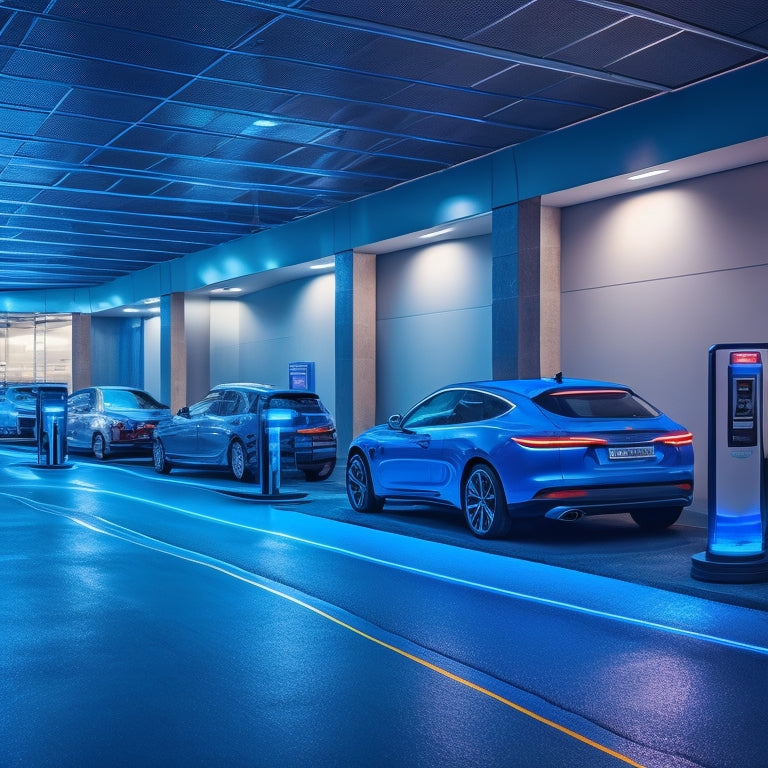
What Makes a Building's EV Charging Station Efficient?
Share
When designing an EV charging station for your building, you'll want to prioritize efficiency. Start by selecting a high-power charger that can quickly replenish your fleet's batteries. Then, integrate smart technology to optimize energy distribution and reduce peak demand. Consider connecting to renewable energy sources like solar or wind power to reduce your carbon footprint. A well-designed station with efficient cable management and a user-friendly interface is also essential. Finally, implement advanced load management systems to regulate power distribution and minimize strain on the grid. As you optimize your charging station, you'll uncover even more opportunities to streamline your operations.
Key Takeaways
• A high-power charging capacity with a minimum of 350 kW enables fast charging, replenishing 80% of the battery in under 30 minutes.
• Smart charging technology integration with machine learning optimizes energy distribution, reduces peak demand, and provides real-time updates on energy consumption.
• Connection to renewable energy sources like solar or wind power reduces reliance on the grid, carbon footprint, and energy expenditure.
• Efficient charging station design with strategically positioned charging points, efficient cable management, and a user-friendly interface ensures maximum throughput and safety.
• Advanced load management systems regulate electrical power distribution, minimize strain on the grid, and adjust to grid conditions to ensure multiple EVs can charge simultaneously.
High-Power Charging Capacity
As you specify the EV charging station's architecture, high-power charging capacity becomes a critical factor, particularly when catering to a large fleet of vehicles or supporting high-speed charging corridors.
You'll need to take into account the peak power output required to support your fleet's charging needs. A higher peak power capacity enables faster charging speeds, reducing downtime and increasing efficiency.
For instance, a 350 kW charger can replenish a battery to 80% in under 30 minutes, making it ideal for high-traffic areas. When selecting a charger, think about the charging speed you need. Do you require ultra-fast charging or level 2 charging?
Smart Charging Technology Integration
Your EV charging station's operational efficiency relies heavily on smart charging technology integration. This integration enables optimizing energy distribution, reducing peak demand, and minimizing strain on the electrical grid. By leveraging machine learning algorithms, usage patterns can be analyzed to adjust charging rates in real-time and prevent overloading.
This advanced technology also allows for load balancing, ensuring efficient energy distribution across multiple charging points. An intuitive user interface enables remote monitoring and control of the charging station, providing real-time updates on energy consumption and performance.
With smart charging technology integration, complete control over the EV charging station's performance is achieved. This guarantees maximum efficiency and minimal downtime.
Renewable Energy Source Connection
You can take your EV charging station's efficiency to the next level by connecting it to a renewable energy source, such as solar or wind power. This not only reduces your reliance on the grid but also minimizes your carbon footprint.
By achieving grid parity, you'll be generating electricity at a lower cost than the grid, making your EV charging station even more efficient.
Energy harvesting from renewable sources allows you to harness natural resources, reducing your building's dependence on fossil fuels. This connection enables you to optimize your energy consumption, reducing your building's overall energy expenditure.
Efficient Charging Station Design
Ideally designed charging stations minimize downtime and maximize vehicle throughput by strategically positioning charging points, efficient cable management systems, and intuitive user interfaces.
When you plan a charging station, you'll want to prioritize cable management to reduce clutter and improve safety. A well-organized station layout guarantees that cables are neatly stored and easily accessible, reducing the risk of tripping hazards and damage to equipment.
Advanced Load Management Systems
Advanced load management systems intelligently regulate the distribution of electrical power to minimize strain on the grid, ensuring that multiple EVs can charge simultaneously without overloading the system.
You can optimize your building's EV charging station efficiency by implementing advanced load management systems that utilize peak shaving and demand response strategies. Peak shaving reduces energy consumption during peak hours, while demand response adjusts energy usage in response to changes in grid conditions.
Frequently Asked Questions
Can EV Charging Stations Be Installed in Existing Buildings?
You can install EV charging stations in existing buildings, but you'll face retrofitting challenges, requiring building code compliance and potentially costly electrical upgrades to support the added power demand.
How Do I Choose the Right EV Charging Station for My Building?
When selecting an EV charging station for your building, you'll want to take into account the station's capacity and charger speed to make sure it meets your needs, balancing cost, convenience, and the number of vehicles to be charged.
Are EV Charging Stations Compatible With All Types of Electric Vehicles?
"When you're in the driver's seat, you want to know if EV charging stations are compatible with all electric vehicles. The answer is yes, thanks to Vehicle Classification and Charger Standardization, ensuring a seamless charge, every time, with any ride."
Can EV Charging Stations Be Used for Both Personal and Public Use?
You can configure EV charging stations for both personal and public use by implementing access control and user authentication measures, ensuring secure and restricted access to the station for authorized users only.
Do EV Charging Stations Require Frequent Maintenance and Repairs?
As you operate an EV charging station, you'll find that minimizing downtime is essential; regular maintenance costs and adhering to strict repair schedules will guarantee your station runs smoothly, avoiding costly surprises down the line.
Related Posts
-

How to Upgrade Your Home With Geothermal Innovations
You're now on the cusp of utilizing the Earth's natural thermal energy to revolutionize your home's heating and cooli...
-

7 Best Automated Sprinklers for Water-Wise Green Homes
You're likely among the 75% of U.S. homeowners who use in-ground sprinkler systems, and coincidentally, you're also c...
-

3 Eco-Friendly Automated Blinds for Contemporary Living
You're looking to raise your living space with automated blinds that not only exude contemporary style but also align...


